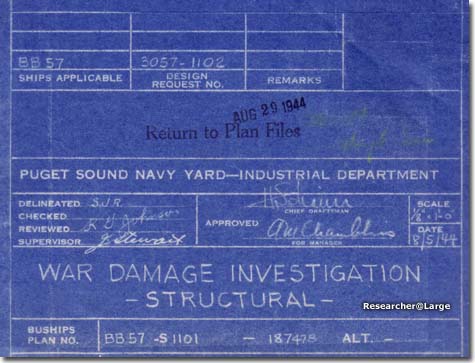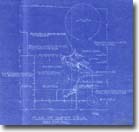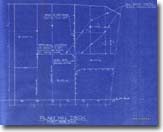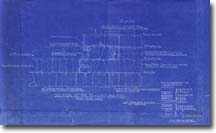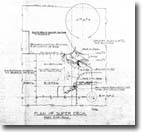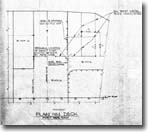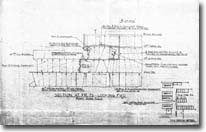If you can see this text here you should update to a newer web browser
Normal | Highlight & Comment Highlighted Text will be in Yellow.
| *WARNING* Photos 1 & 2 in this report are of a graphic nature; those who are troubled by photographs of deceased servicemen should avoid them. That said, how many of you are now going to look for them first before reading any of the report? |
|
CONFIDENTIAL
U.S.S. SOUTH DAKOTA (BB 57) WAR DAMAGE REPORT 19 JUNE 1944
PUGET SOUND NAVY YARD
|
CONFIDENTIAL WAR DAMAGE REPORT U.S.S. SOUTH DAKOTA (BB57) Prepared by Puget Sound Navy Yard TABLE OF CONTENTS
|
|||||||||||||||||||||||||||||||||||||||||||||||||||||||||||||||||||||||||||||
|
Sm
CONFIDENTIAL
Section III - STRUCTURAL
l. The principal structural damage occurred in the immediate vicinity of the bomb hit although fragments pierced structure at some distance from this point and the blast deflected or destroyed light divisional bulkheads and fixtures on the main and Ol decks. The radius about the point of impact within which appreciable damage occurred is approximately 20 feet. 2. The hole torn in the 01 deck at the point of the explosion is shown on the ships photograph's nos. 1, 2, 14, 19, 28, 36, 42, and 46 and the attached sketch. The temporary patch installed over the hole appears on P.S.N.Y. photographs nos. 2217-44, 2218-44, and 2225-44. The portion of the deck house bulkhead which was blown in is shown on the ships photographs nos. 2 and 46 and the attached sketch. A temporary patch was also installed over this hole and is shown on P.S.N.Y, photographs nos. 2221-44, 2222-44, and 2225-44.3. It is of interest to note that the light sheet metal bulkhead on frame 89, starboard side, and shown on ships photograph no. 41, was bulged aft, although it was about 80 feet from the point of explosion and the intervening structure was not affected. 4. It was noted that in most cases, damaged welded stiffeners, deck beams, and welded seams in decks and bulkheads within the blast area were broken adjacent to the weld and parallel to it. One instance of this is shown on ship's photographs nos. 21 and 22. 5. The additional photographs herewith and the ship's report, reference (a) give a detailed picture of the damage which need not be repeated in this report. 6. It is believed that the ship's structure stood up well under the effects of the explosion and no major changes in design are warranted. It does appear however, that increased protection for gun crews on the inboard side of gun mounts would be desirable.
- 4 -
|
|
Sm
CONFIDENTIAL
SECT. V - VENTILATION (Continued)
- 7 -
|
|||||||||||||||||||||||||||||||||||||||||||||||||||||||||||||||||||||||||||||||||||||||||||||||||||||||||||||||||||||||||||||||||||||||||||||||||||||||||||||||||||||
|
Sm
CONFIDENTIAL
SECT V - VENTILATION (Continued)
- 8 -
|
|||||||||||||||||||||||||||||||||||||||||||||||||||||||||||||||||||||||||||
|
Sm
CONFIDENTIAL
SECT. VI - ELECTRICAL 1. The greatest damage to electrical equipment occurred in the port passage on the main deck between frames 68 and 78. A fore and aft cable rack under the 01 deck was located directly under the point of impact and was consequently completely destroyed in this area. Other cables adjacent to the rack, ship's service telephone trunk line, connection boxes, various fixtures and fittings, etc., were also demolished. Some of the above damage can be seen on the ship's photographs nos. 14, 18, 19, 28, 36, 39, and 50. 2. In the case of connection and distribution boxes, fixtures, and fittings, it was observed that in general they were either completely demolished or remained serviceable. On the other hand comparatively delicate instruments such as ship's service telephones, announcing loud speakers, etc., which cannot stand severe shock were extensively damaged as described in reference (a). 3. A great deal of local wiring and equipment in the area just outboard of the centerline, frames 72 to 78 port side, under the Ol deck, was destroyed. However no vital electrical circuits or equipment were located in this area. The ship's photographs nos. 25, 32, and 46 show the general extent of this damage. 4. The destruction of the wire rack and adjacent wiring in passage B-101-L, mentioned in paragraph one above, severed a number of electrical cables which are listed under the heading of either vital or semi-vital and non-vital with comments as follows: VITAL CIRCUITS
- 9 -
|
||||||||||||||||||||||||
|
Sm
CONFIDENTIAL
Section VI - ELECTRICAL (Continued)
- 10 -
|
||||||||||||||||||||||||||||||||||||||||||||||||
|
Sm
CONFIDENTIAL
SECT. VI - ELECTRICAL (Continued)
5. The list furnished in reference (a) appears to accurately cover the details of damaged electrical equipment. 6. From discussion with the ship's officers it was determined that no circuit breakers tripped or fuses dislodged due to shock on the intact circuits. There was no evidence of any sustained short circuits on damaged power or lighting leads. In general, exclusive of the loss of vital circuits to 40 mm Quad. Mount No. 4, it is considered that damage to the electric plant did not impair the immediate military efficiency of the vessel. 7. No damage was sustained by machinery or other electrical equipment.
- 11 -
|
||||||||||||||||||||||||||||||||||||
|
Sm
CONFIDENTIAL
SECT. VII - ORDINANCE 1. Ordnance equipment damage was limited to the 40 mm Quad. Mount No. 4, the 5" loading machine, and 20 MM Ready Service boxes, the details of which are thoroughly covered in reference (a). In connection with the damage to the 40 mm mount involving the severing of electric cables and hydraulic piping by splinters (see ship's photo No. 34) it will be noted that this damage would have been minimized if the splinter shield had been continuous on the inboard side. 2. The 20 mm ready service boxes on the 01 deck, port side frame 67, shown on ship's photograph no. 20 were so badly damaged by fragments that they were thrown over the side. In spite of this severe damage no ammunition in the boxes exploded. However the boxed 40 mm ammunition which had been passed to the Ol deck for the no. 4 mount and was stowed about 10 feet from the point of impact of the bomb all exploded. 3. It is of interest to note that the Radar equipment Mk. 4 transmitter located in the passage between the Admiral's cabin and the Senior Staff Officer's cabin at about frame 76 on the 02 deck which is approximately 30 feet from the point of the explosion was not injured. The transmitter was in operation at the time and continued to operate satisfactorily without the necessity for re-tuning. Since the transmitter operator was thrown 10 to 15 feet by the force of the explosion the transmitter undoubtedly received a severe shock. 4. No damage was sustained by radio or other radar equipment.
- 12 -
|
|
||||||||||||||||||||||||
SOURCE:
National Archives & Records Administration, Seattle Branch
Record Group 181, Ship Files ca 1940-1950
Declassification Review Project NND 958357
Transcribed by RESEARCHER @ LARGE. Formatting & Comments Copyright R@L.
BB-57 South Dakota Home |
Ships Home | Researcher@Large Home
